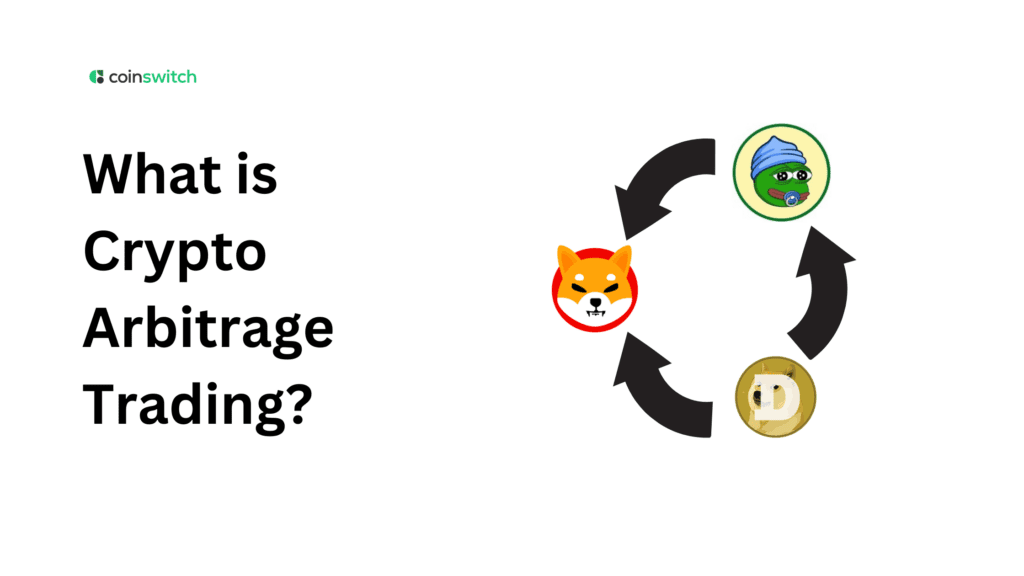Crypto markets are known to be volatile, but interestingly, that opens up opportunities for smart traders. Let’s see how it works. When you see Bitcoin trading at slightly different prices across exchanges, a window opens. That window is where crypto arbitrage lives. At its core, arbitrage trading in crypto means buying on one platform where the asset is cheaper and selling where it’s pricier, pocketing the difference.
This isn’t magic. It’s about speed, risk management, and understanding how markets lag. The moment a price difference appears, dozens of bots try to snatch it. The skill lies in turning those opportunities into consistent gains without being burned by costs, delays, or unexpected issues.
In this blog post, we will discuss how crypto arbitrage works, the types you can run, how trades get executed, what the risks are, and how automation changes everything. You’ll understand why arbitrage is one of the purest tests of trading acumen.
Understanding Crypto Arbitrage Trading
Arbitrage is a concept that existed long before the advent of crypto: buying low in one market and selling high in another, thereby making a profit from market inefficiencies. In the crypto world, because exchanges operate independently and often asynchronously, these inefficiencies occur frequently.
Crypto arbitrage refers to taking advantage of price differences of the same crypto across multiple platforms. The fragmented nature of crypto means that Coin X might trade at $29,900 on Exchange A, but at $30,050 on Exchange B. If you can buy at A and sell at B quickly enough, after accounting for transfer, fees, and slippage, you make a net gain.
That gap emerges due to differences in supply and demand, liquidity, exchange architecture, regional user concentration, trading volume, and latency. But all those gaps exist only briefly. The moment enough traders pounce, the gap closes. So being early, fast, and precise matters.
Arbitrage tends to be seen as a lower-risk play compared to directional bets (betting on the price going up), but it’s not entirely risk-free. Its complexity lies underneath that simple surface: managing execution, ensuring capital is at the right place, and handling failure modes.
Read More: Crypto arbitrage: How to automate trading and maximize profit
Types of Crypto Arbitrage
Arbitrage strategies vary. Let’s walk through the major types that traders use inside crypto.
One is cross-exchange arbitrage. You find the same token priced differently between two exchanges. You buy on one, sell on the other. That’s the classic case. To make it work, you often pre-position funds on both exchanges, so you don’t suffer delays by transferring back and forth in real time.
Another is triangular arbitrage. This one lives inside one exchange. Say the exchange has token pairs A/B, B/C, and C/A. If the conversion path A → B → C → A yields more than you started with (after fees), that’s profit. Essentially, you exploit an internal mismatch within the same platform.
Then there is statistical arbitrage, or algorithmic arbitrage. Traders build models that notice recurring price deviations, correlations, or patterns. When a relationship skews, the bots trade, expecting it to revert. This is more predictive, more model-driven than just spotting static gaps.
There is also cross-chain or inter-chain arbitrage. With many blockchains operating in parallel, you may find the same token (bridged) trading differently across chains or DEXs. That demands bridge efficiency and cross-chain liquidity setup.
Some advanced players attempt latency arbitrage. That is super high speed, spotting micro mismatches that last for milliseconds. It requires colocated servers near exchange data centers, ultra-low latency connections, and blazing fast code. This is the edge case of arbitrage.
Each type has its own demands: capital, infrastructure, risk, connectivity, and complexity.
How Crypto Arbitrage Works
To understand arbitrage in practice, imagine this scenario:
You monitor prices across three exchanges: Alpha, Beta, and Gamma. You notice that ETH is trading for ₹1,50,000 on Alpha, ₹1,51,200 on Beta, and ₹1,50,800 on Gamma. You decide to buy ETH from Alpha, sell some on Beta, and, depending on gaps, move the rest through Gamma.
Here’s how you would ideally execute:
First, you prepare by having balances ready in each exchange: ETH or stablecoin, so you don’t need to wait for transfers. When the gap opens (Beta price > Alpha price by more than your cost buffer), you place a buy on Alpha and a sell on Beta nearly simultaneously. The moment those orders fill, you secure profit. Then you rebalance capital, move ETH or stablecoins across your exchanges, using efficient routes or bridges.
Inside that, many tiny technical pieces matter: the sequence of order placement, fee structure, slippage, order execution time, API latency, and failure handling. Often, arbitrage bots don’t place extremely large trades right away; they start small to test fills, then scale.
The net profit is the price difference minus all costs: withdrawal fees, deposit fees, transaction/gas fees, slippage, and possibly spread costs. If the gap is too small relative to those costs, net profit goes negative. That’s why many traders demand a minimum margin threshold before executing.
Here’s a rough numerical illustration:
ETH on Alpha = ₹3,70,900
ETH on Beta = ₹3,72,000
Difference = ₹1,100
Assume combined fees, slippage, and transfer cost = ₹500
Net profit per ETH = ₹600
If you execute for 5 ETH, gross profit = ₹3,000
That might sound small. But with repeated arbitrage across pairs and automation, those small amounts can compound. Of course, volume, risk, and capital matter a lot.
Read More: Day Trading: The Basics and How to Get Started
Risks Involved in Crypto Arbitrage
Though arbitrage seems like low-hanging fruit, risk is built into every move. You must navigate several danger zones:
One is execution risk. Suppose you place a buy and it fills, but your sell fails or partially fills. You might be left holding the asset while prices move against you.
Transfer delays are huge: Blockchains have variable congestion. If the asset transfer is stuck, you lose the timing advantage. Some exchanges also throttle withdrawals during volatility.
High network/gas fees can kill margins. During busy periods, fees may spike. A trade that looked profitable could become a loss once the cost is added.
Slippage sucks. Especially with large orders or lower liquidity, you might not get the price you expect. The pool or order book depth matters.
Liquidity constraints: Some exchanges or pairs have thin books. You might not find full fills at the desired price.
Counterparty or exchange risk: Exchanges may go down, freeze withdrawals, or have security lapses. If you hold funds on them, you’re exposed.
Regulatory & compliance risk: Moving funds across exchanges, jurisdictions, or large sums may invite scrutiny.
Bot or system misfires: Your code could be wrong, APIs could fail, logic might misjudge a threshold, or network hiccups disrupt execution. Bots need strong monitoring and fallback logic.
Also, scams blend in. There are arbitrage bot scams that lure users to “autotrade” with promises of guaranteed returns, only to lock funds. Studies show that many scam video ads and contracts labeled “arbitrage bots” have stolen user funds. (Scam detection studies report thousands of rogue contracts)
Lastly, time arbitrage wins shrink. As markets mature and competition intensifies, price gaps close faster, making profit margins lower.
The Role of Automated Trading in Crypto Arbitrage
Automation is almost mandatory. You can’t consistently monitor dozens of exchanges and execute trades in milliseconds by hand. Arbitrage bots and systems are the backbone of this game.
A well-built bot does the following in real time: monitors price across exchanges, computes net margin after fees, triggers orders, tracks execution status, manages capital rebalance, handles errors, and adapts thresholds dynamically. The fastest bots win.
When markets are volatile, human reaction is too slow. Bots keep eyes everywhere. Many arbitrageurs colocate servers near exchange data centers or use direct connections to reduce latency. Some even use machine learning to adjust strategies on the fly.
On decentralized exchanges, bots interact directly with smart contracts. They monitor DEX price feeds, liquidity pools, and arbitrage paths across chains, launching atomic transactions to exploit cross-DEX gaps. When designed properly, these bots can catch gaps before manual traders even see them.
But bots need maintenance. You must monitor logs, handle exceptions, renew API keys, secure the system, and update logic. Bots don’t eliminate risk; they magnify efficiency.
Conclusion
Crypto arbitrage trading sits at the intersection of market inefficiency and execution precision. On paper, it sounds simple: buy low, sell high. In reality, it’s a high-stakes contest of speed, infrastructure, capital, and risk control.
Arbitrage persists because crypto markets are segmented, asynchronous, and volatile. That’s why automation is no longer optional. Bots that execute in milliseconds, rebalance capital, and survive failures are what separate success from loss.
But every edge has risk: fees, transfer delays, slippage, exchange risk, regulatory exposure, and bot errors. You must plan for these, test small, and evolve strategies over time.
If you build it well, crypto arbitrage can offer consistent returns in sideways or volatile markets. But it demands discipline, sharp systems, capital, and humility. The opportunity is real, but surviving the play is where the real challenge lies.
FAQs
1. Is crypto arbitrage profitable?
It can be. Traders buy crypto where it’s cheaper and sell where it’s priced higher. If fees and timing work out, the profit margin holds up.
2. What is the crypto arbitrage process?
Spot a price gap on two exchanges, buy low on one, sell high on the other, all within seconds. Quick execution matters most.
3. How do I start arbitrage?
Open accounts on multiple exchanges, track price spreads, test small trades, and build from there. Many use bots for faster moves.
4. What is an example of arbitrage trading?
If BTC trades ₹1,000 on one exchange and ₹1100 on another, a trader buys low and sells high. The ₹100 gap becomes the margin.








